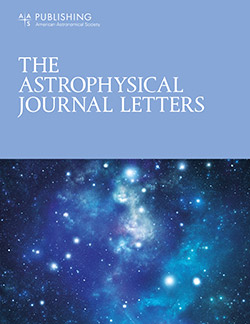DART/二形态碎片轨迹的单次弹射模型
IF 8.8
1区 物理与天体物理
Q1 ASTRONOMY & ASTROPHYSICS
引用次数: 0
摘要
美国宇航局DART航天器与小行星Dimorphos的碰撞导致形成了一条独特且长寿命的碎片轨迹,这是由太阳辐射压力对喷射粒子的作用形成的。这条轨迹短暂地呈现出双重外观,这被解释为双重喷射的结果。我们提出了一个可以产生瞬态双尾的模型,而不需要假设双弹射。我们的模型解释了双轨迹的外观,当从大角度观察到锥轴时,作为锥壁的投影,并避免了单一瞬时撞击在两个时期产生灰尘的问题。颗粒粒径呈幂律破碎分布,微分指数q = 2.7±0.2 (1 μ m≤a≤2 mm), 3.9±0.1 (2 mm <A≤1cm), 4.2±0.2 (1cm <A≤20cm)。我们发现,1 μ m到20 cm大小的颗粒(假设密度为3500 kg m - 3)的总尾迹质量为1.7 × 10.7 kg,当扩展到半径为3.5 m的巨石时,尾迹质量上升到2.2 × 10.7 kg。这相当于Dimorphos质量的0.4%-0.6%。本文章由计算机程序翻译,如有差异,请以英文原文为准。
A Single Ejection Model of the DART/Dimorphos Debris Trail
Abstract The collision of the NASA DART spacecraft with asteroid Dimorphos resulted in the formation of a distinctive and long-lived debris trail, formed by the action of solar radiation pressure on ejected particles. This trail briefly displayed a double appearance, which has been interpreted as the result of a double ejection. We present a model that can produce a transient double trail without the need to assume a double ejection. Our model explains the appearance of the double trail as a projection of the cone walls when viewed from a large angle to the cone axis and avoids the problem of producing dust in two epochs from a single, instantaneous impact. The particles follow a broken power-law size distribution, with differential indices q = 2.7 ± 0.2 (1 μ m ≤ a ≤ 2 mm), 3.9 ± 0.1 (2 mm < a ≤ 1 cm), and 4.2 ± 0.2 (1 cm < a ≤ 20 cm). We find that the total trail mass in particles from 1 μ m to 20 cm in size (for an assumed density 3500 kg m −3 ) is ∼1.7 × 10 7 kg, rising to 2.2 × 10 7 kg, when extended to boulders up to 3.5 m in radius. This corresponds to 0.4%–0.6% of the mass of Dimorphos.
求助全文
通过发布文献求助,成功后即可免费获取论文全文。
去求助
来源期刊

Astrophysical Journal Letters
ASTRONOMY & ASTROPHYSICS-
CiteScore
14.10
自引率
6.30%
发文量
513
审稿时长
2-3 weeks
期刊介绍:
The Astrophysical Journal Letters (ApJL) is widely regarded as the foremost journal for swiftly disseminating groundbreaking astronomical research. It focuses on concise reports that highlight pivotal advancements in the field of astrophysics. By prioritizing timeliness and the generation of immediate interest among researchers, ApJL showcases articles featuring novel discoveries and critical findings that have a profound effect on the scientific community. Moreover, ApJL ensures that published articles are comprehensive in their scope, presenting context that can be readily comprehensible to scientists who may not possess expertise in the specific disciplines covered.
 求助内容:
求助内容: 应助结果提醒方式:
应助结果提醒方式:


